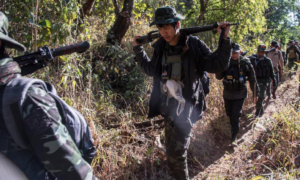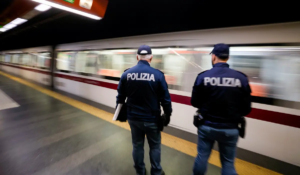By Amy O’Kruk, Kenneth Uzquiano and Anna Brand, CNN
August 30, 2023
For millions of Americans, mass shootings are hitting as close as one mile to home.
Almost 42 million Americans – over one-eighth of the US population – are estimated to have lived within one mile of a mass shooting since 2014, according to an original CNN analysis of data from the Gun Violence Archive (GVA) and US Census Bureau.
Mass shootings are happening both more frequently and in an increasing number of cities and towns across the country. So far, 2023 has been a record-breaking year for gun violence. As of today, there have been over 470 mass shootings, more this year than at the same point in the last 10 years, according to data from the GVA, a non-profit group formed in 2013 to track gun-related violence. Both the GVA and CNN define a mass shooting as an incident where a minimum of four victims are shot, not including the shooter.
To determine the number of people who have lived near mass shootings, CNN examined data from the GVA and the US Census Bureau. Since January 2014, the GVA has provided a daily count of shootings derived from thousands of sources, such as police reports and media articles, checked by a team of researchers. The included mass shootings incorporate hate crimes, domestic violence, gang violence and other categories
While some readers will associate the term “mass shooting” with the country’s most violent and widely reported incidents of gunfire erupting in crowded places, or similarly what the FBI counts as active shooter incidents, these events make up a small fraction of deadly gun violence.
Examining mass shootings captures the daily reality and increasing toll of violent shootings across the country. For the people living near mass shootings, the effects of gun violence can be powerful and enduring too.
A growing body of research has looked at the community impacts of gun violence, finding widespread health consequences. Community-wide, mass shootings lead to increases in feelings of fear and lack of safety, experts say. Among children, witnessing urban violence is a risk factor for adverse outcomes, such as substance abuse, aggression, anxiety, depression and antisocial behavior, according to a 2017 study.
CNN spoke to people who lived near recent mass shootings to try to understand this increasingly common experience. These are their stories.
It’s been a really unique experience… Living in a community that has experienced a mass shooting. It’s been horrifying to watch the emotional toll and the ripple effects of trauma on the kids in the area.
Claire Warner, Highland Park, Illinois.
Highland Park parade shooting
Claire Warner
heard gunshots from the sidewalk.
Distance to mass shooting
Less than a half mile
<0.5 miles
Claire Warner‘s daughter, then 6 years old, was walking in last year’s July Fourth parade in Highland Park, Illinois, when a gunman opened fire, ultimately killing seven people and wounding dozens more. Warner was watching her daughter from the sidewalk with her one-year-old son when she heard gunshots and saw everyone running. Her family was safe, but her daughter was diagnosed shortly afterward with Post Traumatic Stress Disorder.
After a memorial for the victims was set up in the community, her daughter asked to go see it. “She also wanted to make sure it wasn’t still happening,” Warner said. “It took her about a month to get out of the car, but after that she wanted to go back because it was a place of healing for her. I think it was a way for her to not feel so alone in her fear and grief and that sense of community was really important.”
You think it can’t happen here, but it can happen anywhere. It’s a shame that we’re not so shocked anymore.
Mindy Johnson, Chesapeake, Virginia.
Walmart
Mindy Johnson
was a 5-minute drive away.
Distance to mass shooting
Less than one mile
<0.5 miles
1
2
3
5
<20
Mindy Johnson was nearby when a Walmart employee opened fire on coworkerson November 22, 2022, killing six before fatally turning the gun on himself. Instead of fearing the location, Johnson returned to the store in her community shortly after the shooting.
“The first couple of times I was there people were talking about who did or didn’t come back,” Johnson said. “There were a lot of people who were tentative and I was more ‘I’m not going to stay away from places and let people scare me.’ You can’t not go to places because you’re afraid something is going to happen. You can’t not go.”
Living in Texas has been very challenging because of the guns everywhere and the lack of action of our leaders. I’m a sixth-generation Texan. My family came here in 1836. And I’m getting so frustrated. We’re looking at possibly leaving after my daughter graduates from college. It’s terrifying.
Gayle Roberts, Dallas.
Allen Premium Outlets
Gayle Roberts
was driving on the highway.
Distance to mass shooting
Less than 20 miles
<0.5 miles
1
2
3
5
<20
Gayle Roberts was driving on the highway south of Allen, Texas, with her daughter when they saw emergency vehicles. She thought there was just an accident on the road.
“When I got home and I saw the alert on my phone I thought, ‘Oh God, I’m going to have to tell [my daughter].’”
Since that shooting at an outlet mall in Allen on May 6, 2023, where a gunman killed eight people and wounded at least seven others, Roberts doesn’t go anywhere where she might be in a large area, like a movie theater or a concert, showing how pervasive the impact of a shooting can be, even to those who weren’t physically present. Even when she is at places like the vet, she looks around to plan for a safe space in the event of a shooting.
“You have to find a place to hide,” Roberts said.
After her daughter graduates from college in 2026, she and her husband are considering moving out of Texas altogether.
Witnessing an entire community grieve and endure that type of trauma changes you. Many of my students were directly affected as they lost grandparents, great aunts. But many more were affected by the food desert that Tops closing created.
Erika Vertigan, Buffalo, New York.
Tops Friendly Markets
Erika Vertigan
would stop at Tops for snacks for the kids.
Distance to mass shooting
Less than five miles
<0.5 miles
1
2
3
5
<20
Erika Vertigan was a school social worker for ages pre-K to 8th grade in Buffalo, New York, at the time of the racist mass shooting, in which a 19-year-old White man killed 10 people at Tops Friendly Markets in the predominantly Black area on May 14, 2022.
“What do you say to a third grader?” Vertigan said.
“You’ll do whatever you can do to protect those students.”
In the last decade, mass shootings have become more common, especially during the Covid-19 pandemic. According to the CNN analysis, the number of people exposed to mass shootings has grown by about four million people annually, on average, and many residents in neighborhoods across the United States have endured multiple shootings in the last decade. No region of the country has been immune — whether urban or rural — and mass shootings have been recorded in every state, across all types of times, days and seasons.
2014
3,438,482
Americans lived within 1 mile of a mass shootings
2015
9,019,216
Americans lived within 1 mile of a mass shootings
2016
13,454,534
Americans lived within 1 mile of a mass shootings
2017
18,780,827
Americans lived within 1 mile of a mass shootings
2018
22,270,264
Americans lived within 1 mile of a mass shootings
2019
25,723,411
Americans lived within 1 mile of a mass shootings
2020
29,257,392
Americans lived within 1 mile of a mass shootings
2021
34,138,770
Americans lived within 1 mile of a mass shootings
2022
37,921,643
Americans lived within 1 mile of a mass shootings
2023
41,930,273
Americans lived within 1 mile of a mass shootings
High-profile shootings, like the July Fourth parade in Highland Park, Illinois, and the Tops Friendly Markets supermarket shooting in Buffalo, New York, make widespread headlines and spark public debate. But many mass shootings — those that often disproportionately affect marginalized communities — go largely unnoticed in the national media.
Social and economic inequities heighten an area’s risk for gun violence. Black people are particularly exposed, according to research in the journal JAMA Surgery published last month that looked at mass shootings in 51 major metropolitan areas. Mass shootings were more likely in areas with higher Black populations, compared to areas with higher White populations, and Black people were also more at risk of being directly affected, with more injuries and deaths when mass shootings took place, researchers at Tulane University found in their analysis.
https://ix.cnn.io/dailygraphics/graphics/20230629-mass-shootings-ppl-comparison/index.html?initialWidth=1442&childId=20230629-mass-shootings-ppl-comparison&parentTitle=In%20the%20last%20decade%2C%20an%20estimated%2040%20million%20Americans%20lived%20within%201%20mile%20of%20a%20mass%20shooting&parentUrl=https%3A%2F%2Fwww.cnn.com%2Finteractive%2F2023%2F08%2Fus%2Famericans-living-near-mass-shootings-statistics-dg%2F
“While a lot of times, we hear about mass shootings similar to what happened in Las Vegas and Orlando, our study and others show that actually a significant portion of mass shootings, especially in big cities, are community gun violence and inner-city gun violence,” Dr. Sharven Taghavi, principal investigator for the study and associate professor at Tulane University’s School of Medicine, told CNN.
Some of the highest rates of gun violence in cities across the United States are occurring in St. Louis, New Orleans and Baltimore, according to the CNN analysis. New Orleans and Baltimore both have majority Black populations, while St. Louis is majority White, but only by a few percentage points.
Taghavi’s paper suggested that a reason Black communities are disproportionately victimized by mass shootings is the legacy of structural racism, including segregation and discriminatory housing policies like redlining.
The rate of mass shootings since 2014 was over 15 per 100,000 people in New Orleans and Baltimore and as high as 20.9 in St. Louis – the steepest in the country, according to the same analysis. In addition to racial components, studies show sociodemographic factors such as poverty and low education levels among 15-year-olds in large cities also increase chances of exposure to mass shootings. In each of the three cities, geographic patterns emerged and shootings clustered in disadvantaged communities.
https://ix.cnn.io/dailygraphics/graphics/20230807-mass-shootings-cities/index.html?initialWidth=1442&childId=responsive-embed-20230807-mass-shootings-cities&parentTitle=In%20the%20last%20decade%2C%20an%20estimated%2040%20million%20Americans%20lived%20within%201%20mile%20of%20a%20mass%20shooting&parentUrl=https%3A%2F%2Fwww.cnn.com%2Finteractive%2F2023%2F08%2Fus%2Famericans-living-near-mass-shootings-statistics-dg%2F
The effects of gun violence on victims and others connected to the shooting are well documented. For survivors, the mental and physical tolls can last long beyond the shooting itself. Besides the tangible pain of injuries, many shooting victims can develop PTSD. Trauma in general raises the risk of a host of psychiatric, emotional and behavioral problems down the line.
But the emotional impact of a shooting extends beyond firsthand experiences. On a national level, there’s evidence that the trauma of gun violence is impacting the psyche of the country as a whole. Messages to mental health crisis lines have spiked in the wake of some high-profile shootings, and some experts are calling the growing population coping with the psychological effects of shootings a public mental health crisis.
https://ix.cnn.io/charts/4zIL3/4/
https://ix.cnn.io/charts/JeL3L/5/
This year marked a grim milestone of the earliest the country has surpassed 400 mass shootings.
In 2019, it took nearly the entire year, 356 days, to reach 400 mass shootings. This year and in 2021, however, the United States reached that threshold in just seven months. Fatalities and injuries are also at their highest levels since the GVA began tracking incidents. From January through August 27, 508 people have died with over 2,000 people injured. The second highest year for fatalities at this time was in 2021 with 446 deaths and about 1,870 injuries.
There have been only 54 days without a mass shooting, according to GVA data.
This level of unrelenting gun violence is a uniquely American problem. The country’s gun culture is a global outlier: in 2019, the US has the highest firearm homicide rate in the developed world, far exceeding other countries. Other nations have successfully curbed violence through policy. Countries that introduced laws to reduce gun-related deaths saw significant progress, a previous, in-depth CNN analysis found.
But in the US, national legislation is at a standstill. Since President Joe Biden passed the Bipartisan Safer Communities Act — the first new, major national gun legislation in decades — in June 2022, there’s been little new movement and Congressional leaders have not made gun legislation a priority. Even where states and cities have tried to regulate gun ownership or mandate safe storage, like in New York and the District of Columbia, the Supreme Court has struck down those efforts in the name of the Second Amendment. Mass shootings also often lead to an increase in gun sales.
Without new policy measures, millions more Americans every year will learn firsthand what it means to have a mass shooting happen close to home.
“From what I see every day as a trauma surgeon, anybody can be affected by mass shootings,” said Taghavi. “They’re not just some random sporadic event, they actually happen pretty much every day. We need to figure out a solution to this.”
With our interactive map below, you can see how close you live to communities that have experienced a mass shooting.
How far do you live from a mass shooting?
Methodology
To determine the number of people who have lived near mass shootings, CNN used data from the Gun Violence Archive (GVA), a non-profit group formed in 2013 to track gun-related violence, and the US Census Bureau.
The GVA and CNN define a mass shooting as an incident where a minimum of four victims are shot, not including the shooter. CNN examined GVA data going back to January 1, 2014, the date from where the GVA standardized its gun violence records, providing complete information on shooting types for all incidents. To determine the country-wide number of people living in relatively close proximity to a mass shooting, CNN used a computer program to conduct spatial analysis. The process for calculating these estimates involved the following 1) plotting US census block groups with population totals 2) plotting the mass shooting locations 3) calculating 1-mile areas around each shooting location 4) dissolving the individual areas into a total area 5) calculating the percentage overlap of the total area to each census block group to estimate the population living within 1-mile of a mass shooting. CNN performed this analysis for each year since 2014. For each year of the analysis, CNN used corresponding US population estimates from the 2021 5-year American Community Survey. In an effort to use the most recent data possible, CNN used annual periods that ran from August 1 to July 31 as opposed to January 1 to December 31. Since data records began January 1, 2014, the 2014 total reflects a 7-month period.
It is important to note that these numbers are estimates. The number of mass shootings reported by the GVA cannot be exact as it’s subject to change as reports from police, media and other sources are updated and verified or incidents go unreported. This analysis also does not account for people who may have moved during the periods analyzed.
https://www.cnn.com/interactive/2023/08/us/americans-living-near-mass-shootings-statistics-dg/




